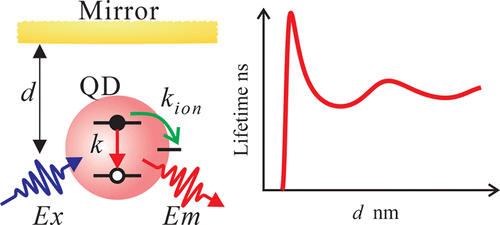当前位置:
X-MOL 学术
›
Nano Lett.
›
论文详情
Our official English website, www.x-mol.net, welcomes your
feedback! (Note: you will need to create a separate account there.)
Tuning Single Quantum Dot Emission with a Micromirror
Nano Letters ( IF 9.6 ) Pub Date : 2018-01-11 00:00:00 , DOI: 10.1021/acs.nanolett.7b04482 Gangcheng Yuan 1 , Daniel Gómez 2 , Nicholas Kirkwood 1 , Paul Mulvaney 1
Nano Letters ( IF 9.6 ) Pub Date : 2018-01-11 00:00:00 , DOI: 10.1021/acs.nanolett.7b04482 Gangcheng Yuan 1 , Daniel Gómez 2 , Nicholas Kirkwood 1 , Paul Mulvaney 1
Affiliation

|
The photoluminescence of single quantum dots fluctuates between bright (on) and dark (off) states, also termed fluorescence intermittency or blinking. This blinking limits the performance of quantum dot-based devices such as light-emitting diodes and solar cells. However, the origins of the blinking remain unresolved. Here, we use a movable gold micromirror to determine both the quantum yield of the bright state and the orientation of the excited state dipole of single quantum dots. We observe that the quantum yield of the bright state is close to unity for these single QDs. Furthermore, we also study the effect of a micromirror on blinking, and then evaluate excitation efficiency, biexciton quantum yield, and detection efficiency. The mirror does not modify the off-time statistics, but it does change the density of optical states available to the quantum dot and hence the on times. The duration of the on times can be lengthened due to an increase in the radiative recombination rate.
中文翻译:

用微镜调谐单量子点发射
单个量子点的光致发光在明亮(打开)状态和黑暗(关闭)状态之间波动,也称为荧光间歇性或闪烁。这种闪烁会限制基于量子点的设备(例如发光二极管和太阳能电池)的性能。但是,闪烁的起源尚未解决。在这里,我们使用可移动的金微镜来确定亮态的量子产率和单个量子点的激发态偶极子的取向。我们观察到,对于这些单个QD,亮态的量子产率接近于1。此外,我们还研究了微镜对闪烁的影响,然后评估了激发效率,双激子量子产率和检测效率。镜像不会修改关闭时间统计信息,但是它确实改变了量子点可用的光学状态的密度,从而改变了导通时间。由于辐射复合率的增加,可以延长接通时间的持续时间。
更新日期:2018-01-11
中文翻译:

用微镜调谐单量子点发射
单个量子点的光致发光在明亮(打开)状态和黑暗(关闭)状态之间波动,也称为荧光间歇性或闪烁。这种闪烁会限制基于量子点的设备(例如发光二极管和太阳能电池)的性能。但是,闪烁的起源尚未解决。在这里,我们使用可移动的金微镜来确定亮态的量子产率和单个量子点的激发态偶极子的取向。我们观察到,对于这些单个QD,亮态的量子产率接近于1。此外,我们还研究了微镜对闪烁的影响,然后评估了激发效率,双激子量子产率和检测效率。镜像不会修改关闭时间统计信息,但是它确实改变了量子点可用的光学状态的密度,从而改变了导通时间。由于辐射复合率的增加,可以延长接通时间的持续时间。











































 京公网安备 11010802027423号
京公网安备 11010802027423号